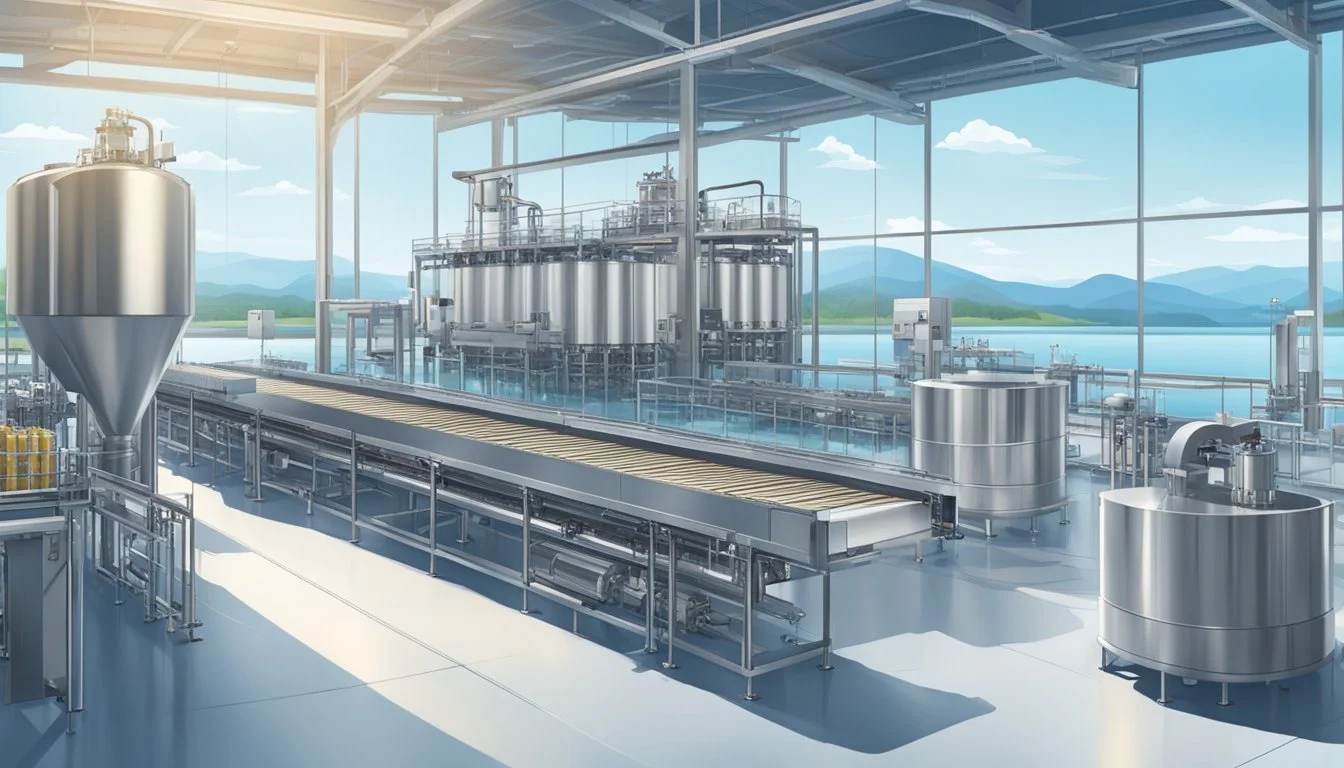Flow vs. Crystal Lake
A Comprehensive Comparison of Bottled Water Quality
When deciding between Flow and Crystal Lake bottled waters, it's essential to consider quality and taste. Flow offers water with naturally occurring minerals, often praised for its clean and crisp taste. In comparison, Crystal Lake's water is known for its pureness and lack of any aftertaste, catering to those who prefer water that is as neutral as possible.
Both brands cater to different preferences when it comes to hydration. Flow's appeal lies in its natural minerals and the subtle flavor they provide. Crystal Lake, on the other hand, prides itself on delivering a pure, no-nonsense hydrating experience.
Selecting between Flow and Crystal Lake often comes down to personal preference. If one values a subtle, natural taste due to minerals, Flow might be the better option. Conversely, for those seeking pure water devoid of any tang or aftertaste, Crystal Lake stands out as the clear choice.
The Importance of Hydration
Proper hydration is essential for maintaining bodily functions and overall health. The balance of electrolytes and fluids within the body is crucial in this regard.
Understanding Hydration
Hydration refers to the process of maintaining adequate fluid levels in the body. Water is integral for various bodily functions, including temperature regulation, nutrient transport, and waste removal.
The human body is composed of about 60% water. This fluid supports cellular processes, lubricates joints, and maintains tissue health, among other functions.
Insufficient hydration can lead to symptoms like fatigue, headaches, and decreased cognitive performance. Therefore, regular water intake is vital for sustaining energy levels and ensuring mental clarity.
The Role of Electrolytes in Hydration
Electrolytes are minerals that carry an electric charge. They are found in bodily fluids like blood and urine and are essential for many vital functions. Key electrolytes include sodium, potassium, calcium, and magnesium.
These minerals help maintain fluid balance, transmit nerve signals, and regulate muscle contractions. They assist in drawing water into cells and expelling waste, thereby supporting hydration.
Athletes and those engaged in intense physical activity may benefit from electrolyte-containing beverages. Such drinks can help replace electrolytes lost through sweat, preventing imbalances that can hinder performance and recovery.
Source and Origin of Waters
The origin of water is crucial in determining the quality and appeal of bottled water. Consumers often consider the source—be it natural springs or treated municipal water—and the method of purification. This section explores the differences between spring water vs. reverse osmosis and highlights natural sources and their environmental impact.
Spring Water vs. Reverse Osmosis
Spring water originates from natural springs, often located in mountainous regions. This type of water is typically mineral-rich due to natural filtration through rock layers, which imparts a distinct taste and contains essential minerals like magnesium and calcium.
Flow, a popular brand, sources its water from protected springs in Canada. It is known for its clean taste and minimal processing, retaining its natural mineral content.
In contrast, reverse osmosis water undergoes a rigorous purification process that removes impurities, including minerals, through a semi-permeable membrane. Crystal Lake utilizes this method, ensuring high purity by filtering out contaminants and additives. This often results in a neutral taste, appealing to those preferring a clean and straightforward hydration option.
Natural Sources and Environmental Impact
Natural spring water sources, such as those used by Flow, are often located in pristine, protected environments, ensuring minimal exposure to pollutants. These sources replenish naturally, supporting environmental sustainability when managed responsibly. Mountain Valley, another renowned brand, sources spring water from Arkansas, maintaining high environmental standards.
Reverse osmosis, while effective for purifying water, typically uses local municipal water supplies. This process can be energy-intensive and may involve significant water wastage. Crystal Lake sources its water from local supplies, filtering it extensively to meet quality standards.
The environmental impact of water sourcing is a pivotal consideration. Sustainable management of natural springs can minimize ecological disruption, whereas the energy usage and waste generated by reverse osmosis processes require careful attention to enhance eco-friendliness.
Health and Safety Considerations
Flow and Crystal Lake bottled water brands are evaluated based on pH balance, mineral content, and safety for consumption. This ensures that consumers can make an informed decision regarding their health.
PH Balance and Alkalinity
Flow Bottled Water typically has a pH of 8.1, classifying it as alkaline water. Alkaline water is believed to neutralize acid in the bloodstream and improve metabolism. Crystal Lake Water, on the other hand, has a pH closer to 7.0, which is neutral on the pH scale. Neutral pH water maintains the balance of bodily fluids without affecting acid-base equilibrium.
Flow's alkaline water can offer potential benefits for people looking to manage hyperacidity issues. Crystal Lake's neutral pH can be more suitable for general hydration purposes.
Mineral Content and Health Benefits
Flow water contains minerals like magnesium, calcium, and potassium. These minerals contribute to overall health by supporting bone strength and cardiovascular function. Crystal Lake water also offers essential minerals but in varying amounts. For instance, Crystal Lake might have higher sodium content, which could be a consideration for individuals monitoring salt intake.
Flow:
Magnesium: Supports muscle and nerve function.
Calcium: Important for bones and teeth.
Potassium: Helps maintain normal blood pressure.
Crystal Lake:
Variable mineral content, may contain higher sodium levels.
These differences in mineral content can influence the choice depending on individual health needs.
Safety and Purity of Drinking Water
Studies and reports indicate that bottled water can contain various contaminants. Consumer Reports found toxic PFAS chemicals in several popular brands, including some carbonated waters. Furthermore, nearly 64% of bottled water in America is essentially treated tap water, which might include contaminants like caffeine and fertilizers.
Flow and Crystal Lake brands need regular testing to ensure they meet safety standards. Flow boasts plant-based packaging that may reduce plastic contamination. Criteria for safe drinking water include the absence of toxins and compliance with health guidelines.
Regular audits and transparent reporting are crucial for both brands to maintain customer trust and ensure the water is safe for consumption.
Comparison of Bottled Water Brands
When comparing bottled waters like Flow and Crystal Lake, it's essential to consider factors such as market reputation, critical reviews of popular brands, and taste tests conducted by experts.
Reputation and Consumer Trust
Flow water and Crystal Lake are two popular brands in the bottled water market. Flow is widely recognized for its environmental packaging and emphasis on sustainability. Crystal Lake also enjoys consumer trust but doesn't market its eco-friendly efforts as strongly as Flow. Brands such as Evian, Fiji Water, and Voss boast strong reputations for purity and taste. Reviews often highlight Evian's natural spring source and Fiji’s unique mineral profile. Dasani and Aquafina are reputable due to their association with major beverage companies like Coca-Cola and PepsiCo, which engenders trust among consumers.
Critical Analysis of Popular Brands
A critical analysis of Flow and Crystal Lake reveals nuanced differences. Flow is often praised for its clean, crisp taste and distinctive mineral content. Crystal Lake is appreciated for its refreshing quality but lacks the distinctive marketing angle of Flow. In broader comparisons, brands like Fiji and Evian stand out for maintaining high mineral content and natural sources. Nestlé Pure Life and LIFEWTR are criticized for added ingredients like artificial sweeteners and preservatives. Smartwater and Core receive positive notes for their purification processes and added electrolytes, enhancing both taste and hydration benefits.
Taste Tests and Water Sommelier Reviews
Taste tests offer critical insights into consumer preferences. Flow is known for its slightly alkaline taste and smooth finish, preferred by health-conscious consumers. Water sommeliers often praise Fiji and Evian for their balanced flavor profiles. Crystal Lake tends to have a neutral taste, making it a versatile choice but sometimes considered less memorable in expert reviews. Acqua Panna and Voss are often noted for their luxurious taste and smooth mouthfeel. For many consumers, the taste is a decisive factor, making these reviews crucial. Frequent consumers and sommeliers contribute heavily to the nuanced understanding of bottled water quality beyond marketing claims.
Overall, these comparisons reveal that the choice of bottled water brand can vary significantly based on factors such as reputation, critical feedback, and taste preferences.
Environmental and Economic Impacts
The environmental footprint and cost implications of bottled water are significant factors when evaluating the merits of Flow versus Crystal Lake. These aspects influence consumer choices and have broader societal impacts.
Bottled Water and the Environment
Bottled water production contributes heavily to environmental degradation. Bottled water like Crystal Lake often uses PET plastic containers, which are not biodegradable. This leads to significant plastic waste.
A new study shows that bottled water's environmental impact is approximately 3,500 times greater than tap water. This is due to the life-cycle analysis of bottle production, which includes extraction, processing, and transportation.
Flow aims to mitigate this by using paper-based packaging, which is more sustainable than plastic. The use of reusable bottles and glass can further reduce the environmental impact, as these materials are easier to recycle and have a longer lifespan.
Cost Implications for Consumers
Bottled water also has significant cost implications for consumers. On average, bottled water is sold at a much higher price than tap water. This difference is seen prominently with Crystal Lake, often priced at a premium for its perceived quality.
Flow offers a more economical choice for consumers who are environmentally conscious. Although the initial price may be higher, the sustainability of its packaging could provide long-term economic benefits by reducing waste disposal costs.
An effective alternative for cost-saving is using reusable bottles. These can be refilled with either tap water or filtered water, which is a much more cost-effective and environmentally friendly option.
Innovation in Packaging and Delivery
In the competitive bottled water market, innovation in packaging and delivery has become crucial. This section explores recent advancements in packaging and the adoption of sustainable alternatives.
Advancements in Bottled Water Packaging
Recent developments in bottle design focus on improving functionality, reducing waste, and enhancing user experience.
Glass bottles have gained popularity due to their reusability and premium feel. Although they are heavier and more fragile compared to plastic, their ability to be recycled endlessly without quality degradation makes them a preferred choice for eco-conscious consumers.
Reusable bottles are also on the rise, offering consumers a sustainable way to stay hydrated while reducing single-use plastic waste. Brands are creating bottles with innovative features such as built-in filtration systems and collapsible designs, making them convenient for modern lifestyles.
Boxed Water is a noteworthy innovation, with packaging that is 92% plant-based, significantly reducing its petroleum-based content. This type of packaging aims to tackle plastic waste while being more biodegradable than traditional plastic bottles.
Sustainable Alternatives and Solutions
To address environmental concerns, companies are exploring sustainable packaging options.
JUST Water utilizes Tetra Pak cartons made from 82% renewable resources. The paper-based carton, aluminum lining, and bio-plastic cap make it an environmentally friendly choice. JUST Water focuses on reducing carbon footprint by sourcing materials responsibly and ensuring recyclability.
Boxed Water Is Better is a leader in this space with its 92% plant-based packaging, made mainly from paper sourced from well-managed forests. This type of packaging not only reduces reliance on fossil fuels but also degrades more easily compared to plastic.
Some brands are also experimenting with edible packaging. Although still in experimental stages, this innovation could potentially eliminate waste altogether if it becomes commercially viable.
These efforts reflect an industry-wide shift towards sustainable practices, aimed at reducing the environmental impact of bottled water consumption.
The Science of Water Filtration and Purification
Water filtration and purification involve various methods designed to remove impurities and contaminants, ensuring the water is safe and palatable. These processes enhance the quality of water, making it fit for consumption and other uses.
Methods of Filtration
The most common methods of filtration include reverse osmosis, activated carbon filters, and ceramic filters.
Reverse osmosis works by forcing water through a semi-permeable membrane. This membrane acts like a sieve, allowing only water molecules to pass through while blocking contaminants like dissolved salts, bacteria, and viruses.
Activated carbon filters function by adsorbing impurities onto the surface of the carbon particles. This method is excellent for removing chlorine, odors, and organic compounds.
Ceramic filters use porous ceramic material to physically block larger particles and bacteria. This method is straightforward and effective for eliminating larger contaminants but may not remove smaller dissolved substances.
Benefits of Purification Processes
Water purification processes offer multiple benefits. Reverse osmosis, for example, provides highly purified water by removing a broad spectrum of contaminants.
Natural filtration methods avoid the use of chemicals such as chlorine or iodine, providing a more organic approach to water purification. This is particularly appealing to households seeking chemical-free water options.
Additionally, these processes often improve the taste and odor of water, making it more enjoyable to drink. Removing impurities ensures that the water is not only safe but also pleasant for everyday use.
Advantages and Drawbacks of Alkaline Water
Alkaline water, often touted for its potential health benefits, has a higher pH than regular water. Claims about its advantages, such as detoxification and disease prevention, remain controversial and require further research.
Understanding pH and Alkalinity
Alkaline water possesses a pH level above 7 due to the presence of alkaline minerals like magnesium.
Regular water typically has a neutral pH of 7.
Ionized or artificially alkalized water gains its properties through electrolysis, altering the water's electric charge.
Naturally alkaline sources, such as mineral water, derive their high pH from natural processes. Brands like Essentia Water and Flow market their products based on this characteristic.
Health Claims of High pH Water
Advocates claim that alkaline water neutralizes acid in the bloodstream and may contribute to disease prevention.
Studies and expert reviews, however, find insufficient evidence to support such claims conclusively.
Suggestions that it improves liver function, prevents diabetes, and slows aging remain scientifically unsubstantiated.
Hydration, being crucial, doesn't necessarily require high pH water; regular tap or bottled water suffices for most needs.
Contrary to some claims, no credible research confirms that alkaline water can treat or prevent cancer or heart disease.
Conclusions
This section consolidates the comparative analysis between Flow and Crystal Lake bottled waters, providing recommendations and a final verdict on which is better.
Summary of Comparative Analysis
The comparative analysis highlighted several critical factors, including taste, purity, and price. Flow offers alkaline spring water that is naturally sourced and eco-friendly, packaged in renewable materials. Their water has a soft mineral taste that comes from being highly alkaline.
Crystal Lake, on the other hand, is known for its purity and clean taste, boasting extensive purification processes. It is sourced from a deep aquifer, ensuring a fresh experience. However, its plastic packaging may raise environmental concerns.
Final Recommendations
Flow appears to be an excellent choice for those prioritizing sustainability and a unique mineral taste. Its eco-friendly packaging and alkaline nature give it an edge in terms of health benefits and environmental impact.
Crystal Lake is perfect for consumers who value utmost purity and a clean water taste. Despite its less eco-friendly packaging, the taste and purity make it a strong contender.
For daily hydration with an emphasis on sustainability, Flow may have the slight advantage. Those who prefer a very clean palate might lean towards Crystal Lake.
The Bottom Line
Choosing between Flow and Crystal Lake ultimately boils down to personal preferences and priorities. If eco-friendliness and a distinct alkaline taste are important, Flow is the way to go. For those who need exceptionally pure, clean-tasting water, Crystal Lake stands out. Each brand has its strengths, making them suitable for different consumer needs.
More About Flow
Flow vs Whole Foods Italian Still Mineral water: Which Bottled Water is Better?
Mountain Valley Spring Water vs Flow: Which Bottled Water is Better?
More About Crystal Lake
Aqua Carpatica vs Crystal Lake: Which Bottled Water is Better?
Cascade Mountain vs Crystal Lake: Which Bottled Water is Better?
Core Hydration vs Crystal Lake: Which Bottled Water is Better?
Crystal Geyser vs Crystal Lake: Which Bottled Water is Better?
Crystal Lake vs Essence pH10: Which Bottled Water is Better?
Crystal Lake vs Proud Source: Which Bottled Water is Better?
Hawaii Volcanic vs Crystal Lake: Which Bottled Water is Better?
Hawaiian Springs vs Crystal Lake: Which Bottled Water is Better?
Ice Mountain vs Crystal Lake: Which Bottled Water is Better?
Icelandic Glacial vs Crystal Lake: Which Bottled Water is Better?
Kirkland Signature vs Crystal Lake: Which Bottled Water is Better?
Liquid Death vs Crystal Lake: Which Bottled Water is Better?
Mountain Valley Spring Water vs Crystal Lake: Which Bottled Water is Better?
Nestle Pure Life vs Crystal Lake: Which Bottled Water is Better?
Poland Spring vs Crystal Lake: Which Bottled Water is Better?
Purely Sedona vs Crystal Lake: Which Bottled Water is Better?
Richard's Rainwater vs Crystal Lake: Which Bottled Water is Better?
San Pellegrino vs Crystal Lake: Which Bottled Water is Better?
Simple Truth vs Crystal Lake: Which Bottled Water is Better?
Solan de Cabras vs Crystal Lake: Which Bottled Water is Better?
Talking Rain AQA vs Crystal Lake: Which Bottled Water is Better?
Whole Foods 365 vs Crystal Lake: Which Bottled Water is Better?
Whole Foods Italian Still Mineral water vs Crystal Lake: Which Bottled Water is Better?








